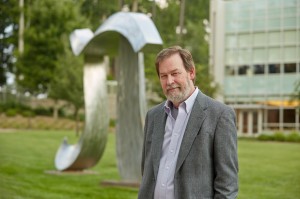 Light years from Earth, within the constellation Virgo, two galaxies crashed into one another. Not something you could’ve seen peering into the night sky with the naked eye.
Light years from Earth, within the constellation Virgo, two galaxies crashed into one another. Not something you could’ve seen peering into the night sky with the naked eye.
We know it happened because astronomers pieced together images from several powerful telescopes to create what CBS News called a “cosmic magnifying glass.” With it, they documented an otherwise imperceptible event.
A video illustrating their discovery is startling – and thought provoking.
It brought to mind an amateur astronomer in Chicago named Robert H. Gray, who uses SAS in his search for radio signals from other worlds.
Yes, you read that right. SAS has a role in searching the universe for intelligent life!
Gray, a SAS user since 1978, has been on a quest for extraterrestrial intelligence for three decades. His book, The Elusive Wow: Searching for Extraterrestrial Intelligence, documents his journey. It also chronicles the discovery of an unusual radio signal from space. Recorded in 1977 at Ohio State University, the signal suggests earthlings aren’t the only sentient beings in our universe.
A 2012 article on Gray in The Atlantic summarizes the signal’s discovery:
Late one night in the summer of 1977, a large radio telescope outside Delaware, Ohio intercepted a radio signal that seemed for a brief time like it might change the course of human history. The telescope was searching the sky on behalf of SETI, the Search for Extraterrestrial Intelligence, and the signal, though it lasted only seventy-two seconds, fit the profile of a message beamed from another world. Despite its potential import, several days went by before Jerry Ehman, a project scientist for SETI, noticed the data. He was flipping through the computer printouts generated by the telescope when he noticed a string of letters within a long sequence of low numbers – ones, twos, threes and fours. The low numbers represent background noise, the low hum of an ordinary signal. As the telescope swept across the sky, it momentarily landed on something quite extraordinary, causing the signal to surge and the computer to shift from numbers to letters and then keep climbing all the way up to "U," which represented a signal thirty times higher than the background noise level. Seeing the consecutive letters, the mark of something strange or even alien, Ehman circled them in red ink and wrote "Wow!" thus christening the most famous and tantalizing signal of SETI's short history: The "Wow!" signal.
The article calls Gray the signal’s “most devoted seeker and chronicler, having traveled to the very ends of the earth in search of it.”
It’s fascinating to read about his descriptions of combing through data from outer space and his thoughts on life on other worlds.
“The Wow signal has proven awfully elusive and it might turn out to be just a big fish story,” he said, “but it’s the strongest tug on the cosmic fishing line that anybody’s gotten, so I plan to keep looking.
“A fair number of scientists think that intelligent beings might live on some other worlds and might broadcast signals that we might be able to detect.”
Searching for extraterrestrials “an application for SAS”
Most searches involve pointing a big radio telescope dish antenna at a star and using a spectrum analyzer to monitor up to millions of frequency channels at the same time, like tuning lots of radios to adjacent frequencies. Searches look for channels with a stronger hiss than the background noise that’s always present in space.

“It’s complicated by our own local radio interference and radio emissions from natural radio sources,” Gray said. “That makes searching for intelligent extraterrestrial signals a data analysis problem, hence an application for SAS.”
I’ve worked at SAS long enough that I’m no longer surprised to find out our software is doing mind-boggling things. In this case, we have someone crunching data from space for an otherworldly purpose who, using the same software, worked a day job sifting securities and census data with SAS.
“I once created simulated stock market trading to calculate investors’ losses when a big company’s stock drops hard and lawsuits are filed,” Gray said. “I used a hundred pages of SAS code to estimate losses under various assumptions that arise in litigation, often amounting to billions of dollars.”
Currently, Gray and a University of Tasmania faculty member are waiting for a turn to gather data via the university’s 26-meter radio telescope. They’ll record 4,096 channels of data at five-second intervals for several days. They’ll be looking for a radio signal coming from outside our solar system, using various techniques to screen out any local radio signals.
“A signal from an extraterrestrial civilization would probably look like a big spike in a SAS scatter plot of the loudness of receiver noise across thousands of frequency channels or a big circle on a SAS bubble plot of the radio brightness of an area of the sky,” Gray said.
“Just finding a radio signal coming from near a star would be pretty amazing, because no known natural process does that – it would suggest, but not quite prove, that someone is out there and is broadcasting.”
If he finds such a signal in the data, Gray would turn it over to top astronomers to double and triple check. Researchers would then try to find out what the signal means. “It might be just a dial tone, or a navigational beacon, or a simple message, or an encyclopedia, or an interstellar Internet, or something we can’t imagine,” he said. “I like the idea of a ‘Wild Kingdom’ nature program from another world.”
As the astronomers who discovered the colliding galaxies found, it’s important to pay attention to incoming data. Otherwise we might miss something important.
“We’ll scan the data both visually and analytically to see if the elusive signal is lurking out there,” he said. “If we do find something interesting, SAS will have a role in the discovery.
“I’m very grateful to everyone at SAS for making such a powerful tool available and hope that in the not-too-distant future I’ll be able to report finding something interesting!”
Discover more interesting uses of SAS.

